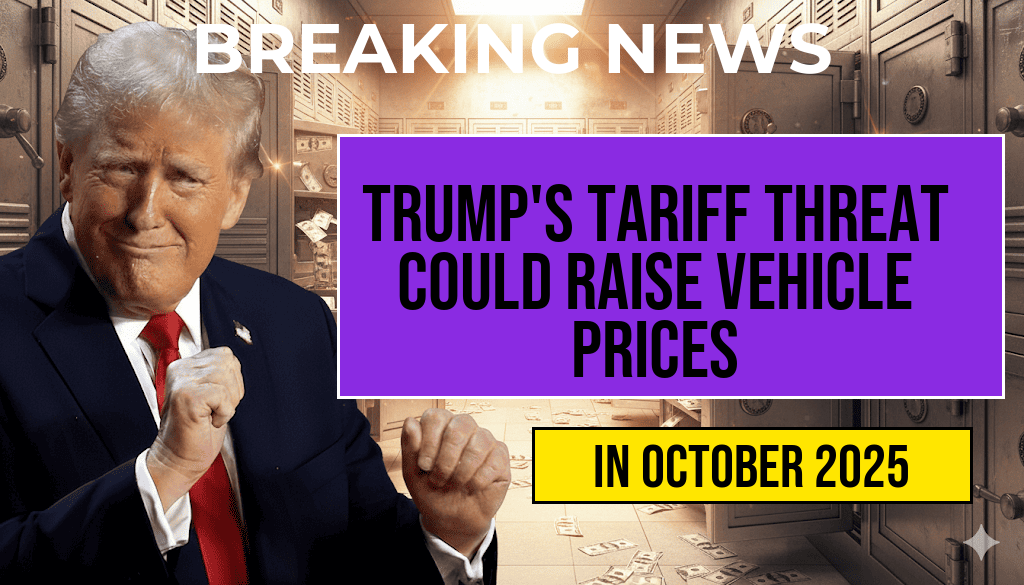Former President Donald Trump’s recent tariff threats could lead to significant increases in vehicle prices, with estimates suggesting that costs for consumers might soar by as much as $5,286 per vehicle. This potential price surge is tied to Trump’s intentions to impose tariffs on automotive imports, a move that has sent ripples through the automotive industry and raised concerns among consumers and manufacturers alike. Analysts warn that such tariffs could exacerbate the ongoing supply chain issues already affecting the market, leading to higher prices at a time when inflation remains a pressing concern across the economy.
Understanding the Tariff Implications
Tariffs are taxes imposed on imported goods, and Trump’s proposed levies would primarily target vehicles and auto parts coming from outside the United States. The rationale behind such tariffs is to boost domestic manufacturing by making imported vehicles more expensive, thereby encouraging consumers to purchase American-made products. However, industry experts argue that this approach could backfire, leading to increased costs for consumers and reduced availability of vehicles.
Projected Costs for Consumers
The impact of these tariffs is expected to be substantial. According to a recent analysis from the Forbes, the average price increase per vehicle could reach as high as $5,286. This increase would disproportionately affect lower- and middle-income families, who may find themselves priced out of the market for new vehicles.
Industry Reactions
- Auto Manufacturers: Major automotive manufacturers, including General Motors and Ford, have expressed concern over the potential for tariffs to disrupt their supply chains further. Many companies rely on imported parts for their vehicles, and additional tariffs could force them to pass those costs onto consumers.
- Consumer Advocates: Consumer advocacy groups have raised alarms about the impact of higher vehicle prices on family budgets. They argue that the tariffs would ultimately hurt the very workers and consumers that the tariffs aim to protect.
- Economists: Economic analysts warn that the proposed tariffs could lead to job losses in the auto industry as companies attempt to cut costs in response to decreased sales. This could have a ripple effect throughout the economy, potentially leading to broader economic instability.
Current Market Trends
The automotive market is already facing significant challenges, including supply chain disruptions and semiconductor shortages. These issues have contributed to rising vehicle prices, with many consumers paying more than ever for both new and used cars. According to data from the Wikipedia, the average price of a new vehicle in the U.S. has exceeded $46,000, marking a sharp increase over the past few years.
| Year | Average Price ($) |
|---|---|
| 2020 | 36,000 |
| 2021 | 40,000 |
| 2022 | 44,000 |
| 2023 | 46,000 |
Potential Economic Consequences
The implications of Trump’s tariff threats extend beyond the automotive industry. If implemented, these tariffs could contribute to inflationary pressures on the broader economy, as higher vehicle prices might lead consumers to spend less on other goods and services. Additionally, the U.S. could face retaliatory tariffs from other countries, further complicating international trade relations.
What Lies Ahead?
As discussions around tariffs continue, the automotive industry and consumers are left in a state of uncertainty. Stakeholders are closely monitoring the situation, hoping to mitigate the potential negative effects on vehicle prices and the economy as a whole. The outcome of these tariff proposals may reshape the landscape of the automotive market for years to come, influencing not just the cost of vehicles but also the broader economic environment.
In the coming weeks, industry leaders, economists, and policymakers will need to navigate these challenges carefully to ensure that the automotive market remains robust and accessible to consumers across the economic spectrum.
Frequently Asked Questions
What are the potential impacts of Trump’s tariff threat on vehicle prices?
The tariff threat could potentially drive vehicle prices up by as much as $5,286, significantly affecting consumers and the automotive market.
Which vehicles are most likely to be affected by these tariffs?
Vehicles imported from countries subject to the tariffs, particularly those that rely heavily on foreign parts, are most likely to see price increases.
How do tariffs influence the overall economy?
Tariffs can lead to increased production costs for manufacturers, which may be passed on to consumers through higher prices, potentially slowing down economic growth.
Will these tariffs affect the availability of vehicles?
Yes, if manufacturers face increased costs due to tariffs, they may reduce production or limit the availability of certain vehicle models to manage expenses.
What can consumers do to prepare for potential price increases?
Consumers may want to consider purchasing vehicles before any tariff increases take effect, as this could help them avoid paying higher prices in the future.

Leave a Reply